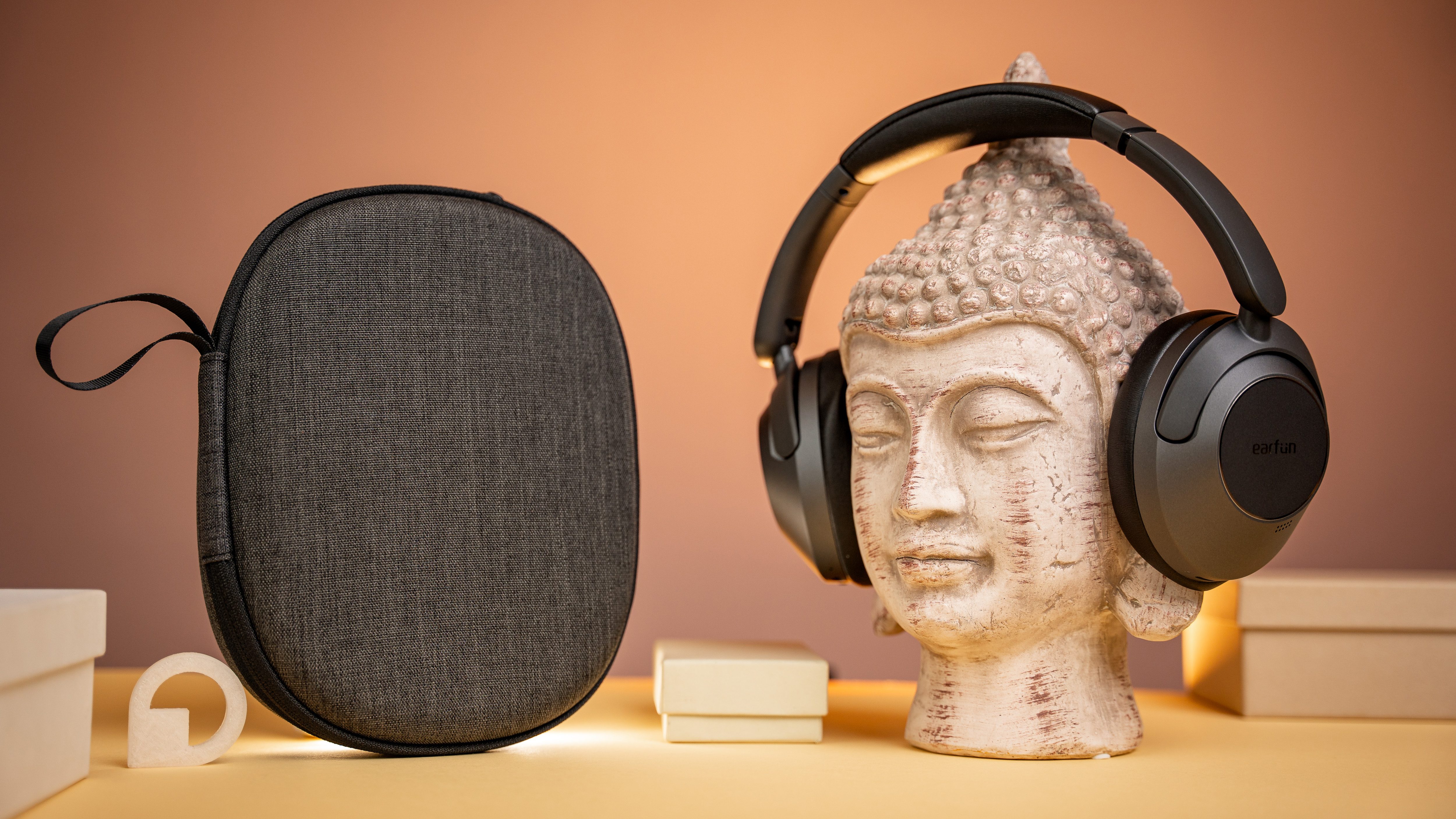
With the Wave Pro, EarFun is launching its first over-ear headphones on the market! This is exciting because the manufacturer’s in-ear models were really convincing in our tests. The question is: Will the audio experts also make the leap to “real” headphones? This is exactly the question we are investigating in the nextpit test of the Earfun Wave Pro!
Good
- Great sound with LDAC enabled
- Surprisingly effective ANC
- Good wearing comfort
- Fantastic battery life of up to 80 hours
Bad
- Occasional connection problems
- ANC changes music too much
- No IP certification
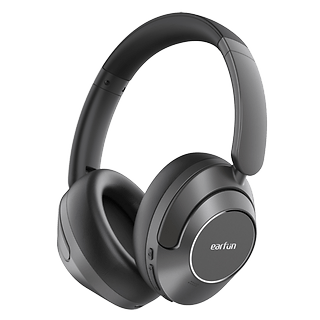
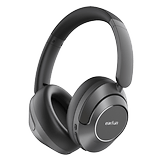
EarFun Wave Pro: All deals
Summary & Buy
In a nutshell: No competitor offers better sound quality thanks to LDAC and a longer battery life (80 hours!) for less than $80. If you’re looking for good, affordable headphones and can live with occasional connection problems, the EarFun Wave Pro are the perfect choice. The headphones are also regularly available at a lower price.
This article was created in cooperation with the manufacturer EarFun. This did not influence the content or the editorial opinion.
Design & build quality
The Wave Pro are being launched as classic over-ear headphones. This means that they completely enclose your ears when listening to music and therefore naturally block out ambient noise. With a weight of 268 g, the headphones are not excessively heavy, but you will have to do without IP certification. However, if you like traveling with headphones, you get a free carrying case.
Pros:
- Good wearing comfort with soft leather pads.
- “Real” buttons instead of touch surfaces.
- USB-C and 3.5 mm jack connection.
Cons:
- No IP certification.
- Operation quite error-prone.
- Ear cups fold in the wrong direction.
The Wave Pro from EarFun are extremely simple over-ear headphones. The design reminds me a little of a mixture of the Bose 700 noise-canceling headphones and the Sony WH-1000XM5. A thoroughly modern look that you could definitely wear on the the streets.
Overall, however, the choice of materials for the Wave Pro is less premium than the high-end headphones mentioned. EarFun relies on plastic throughout the housing, while the earphones are made from “protein leather” according to the manufacturer. By this, the manufacturer is almost certainly referring to a vegan imitation leather that is comfortable even when worn for long periods.
To avoid any misunderstandings: headphones for $80 can certainly be made of plastic. However, I would have preferred metal for better durability, at least for the hinges of the foldable ear cups.
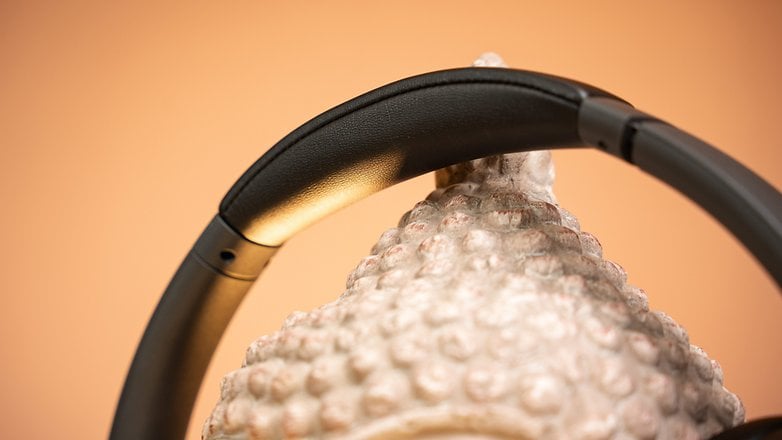
This brings us to two key points: On the one hand, the headphones can be folded up conveniently thanks to the rotating ear cups and stowed away in the bag provided. This is small enough to disappear into a rucksack or large handbag, for example. The second key point relates to durability—because EarFun does not have IP certification or protection against splash water and dust. I wouldn’t use the EarFun Wave Pro in heavy rain.
When folding them up, EarFun also reverses the direction of rotation of the shells. If you put the headphones down and wear them around your neck, the ear cups do not rotate with them. The hinge runs in the opposite direction, which means that the headphones cannot be “rolled off” like some other models, which takes some getting used to, at least for me.
The buttons also take some getting used to. While the in-ear headphones from EarFun were easy to use, I still can’t quite get my head around the Wave Pro even after several days. A long press on the on button switches the headphones on, and they can then be switched off by holding them down.
At the same time, connecting new devices works by pressing the same button three times, and I often found myself switching the headphones on and off again and again when trying to connect them.
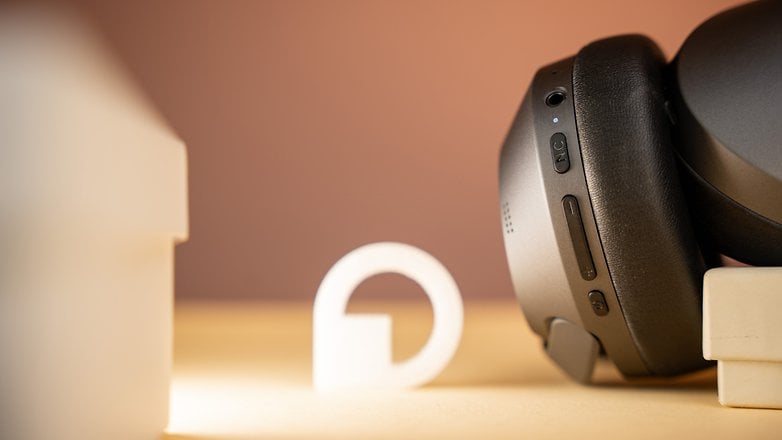
This is a shame, as the controls on the headphones are actually quite good. I like the fact that the manufacturer relies on “real” buttons instead of using touch-sensitive surfaces. The simple assignment of a noise-canceling button and a volume rocker is also a good solution. The fact that there is a USB-C port and a 3.5 mm jack connection is also a positive feature.
App & convenience functions
EarFun provides the Wave Pro with the EarFun app. There you can control the ANC, find an efficient ten-band equalizer, and have the option of connecting two devices simultaneously. However, this function is not available if you want to get the most out of the Wave Pro.
Pros:
- Many control options in the app.
- Good 10-band equalizer.
- Dual pairing possible.
Cons:
- Occasional connection problems.
- Dual pairing is not possible when the LDAC codec is activated.
The EarFun headphones can all be controlled via the same app. The EarFun app is clearly structured and offers a surprising number of functions compared to its counterparts from other manufacturers. You can adjust a ten-band equalizer, switch between different ANC modes, manage the connected devices, and even adjust the headphone controls.
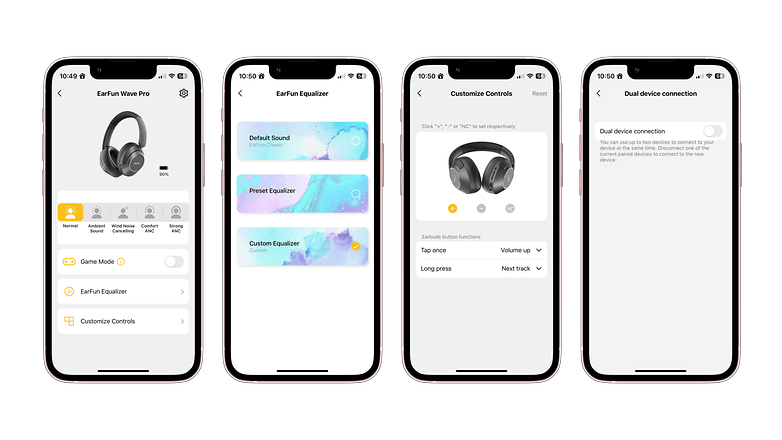
A “game mode” is also available here, which allows you to reduce the latency of the headphones. This can be useful if you’re watching a movie or playing games where there shouldn’t be any delay in the sound.
At this point, I must also point out the headphones’ connection problems. Although I use the latest firmware, it happens from time to time that I have to reconnect the headphones to devices for no apparent reason. During the test period, it also happened several times that the headphones were first displayed as connected and then disconnected again when the music started. I hope that EarFun will be able to improve this with a future software update.
Sound quality & ANC
The Wave Pro use 40 mm carbon drivers for the sound, which should offer a wide frequency response of 40 kHz. A special feature of the headphones is the support of the high-quality
LDAC Bluetooth codec; alternatively, you can also use the headphones wired. The ANC can be controlled in different levels and a transparency mode is also on board.
Pros:
- Wide frequency response of 40 KHz.
- LDAC support and Hi-Res certificate.
- Solid ANC considering the price tag.
Cons:
- Sound is not quite as convincing without LDAC.
- ANC changes the equalizer quite significantly.
- LDAC is not available if you want to use multi-pairing.
Like the EarFun Free Pro 3, the Wave Pro can be seen as an attempt to offer the best possible sound quality at a low price. With LDAC and promising drivers, the manufacturer has integrated the right prerequisites for high-quality music listening. The drivers are 40 mm carbon diaphragms, which are designed to cover a particularly high-frequency response of 40 kHz.
This describes the frequency ranges in which the drivers can process signals. And even if EarFun does not specify the frequency response exactly, the frequency response of 40 kHz is above average. Theoretically, the drivers therefore achieve particularly low bass and particularly high treble frequencies.
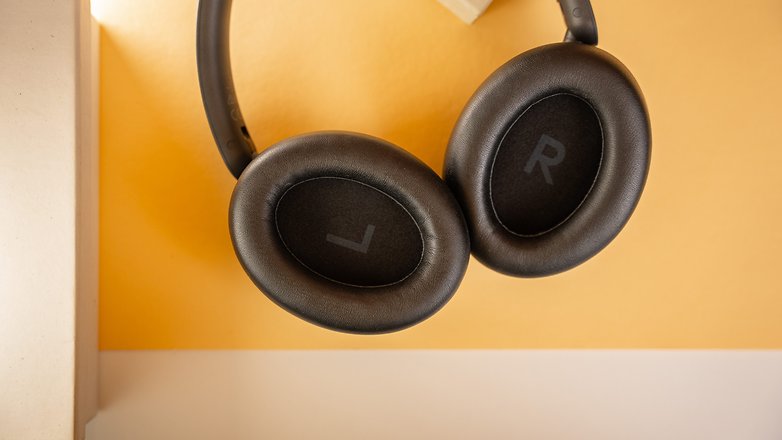
With LDAC support, the Wave Pro also offer the necessary requirements for the Bluetooth codec. Sony’s audio codec is significantly higher resolution than the standard SBC codec and the AAC codec used by Apple. At the same time, it is supported by most Android smartphones—unfortunately, Apple devices are completely excluded from high-quality music enjoyment. LDAC support also gives the Wave Pro Hi-Res certification. A rarity in this price range.
With LDAC activated, the Wave Pro are actually really good headphones. Thanks to the ten-band equalizer integrated into the app, the sound can be adjusted sufficiently to bring out the characteristics of different genres. I was also impressed by the resolution of the individual musical instruments in more complex songs. What I did notice with bass-heavy songs, however, was slight clipping at high volume levels. Although basses are certainly powerful, very low tones tend to be a little imprecise.
These positive impressions are also diminished when I switch from an Android device to my iPhone and thus lose the advantages of the LDAC codec. Or if I want to use the headphones via dual pairing with two devices—LDAC and dual pairing are definitely possible with the EarFun Free Pro 3.
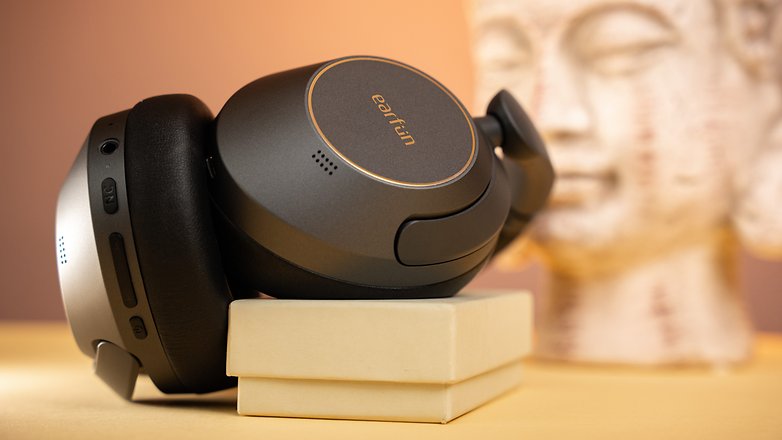
Without LDAC, the sound image becomes significantly “narrower” and the resolution of the instruments diminishes considerably. Of course, these differences are technically justified, but I would not have expected such a noticeable difference.
Unfortunately, the same also applies to wired operation via a jack. This is because the Wave Pro switches itself off when the jack cable is plugged in, which means that it only works passively. The sound is much thinner without the DAC, and my preconfigured equalizer no longer works. Other manufacturers solve this better by allowing both passive and active use.
What really surprised me positively in the test was the integrated ANC. The active suppression of ambient noise can not only be controlled at various levels, but it is also really efficient when turned up to the maximum. And while EarFun’s in-ear headphones with ANC still have a lot of noise and interference, the ANC on the over-ear headphones sounds pleasantly quiet.
What EarFun still needs to solve in future models, however, is the change in the sound of the music playing when ANC is activated. If I switch from “Normal” to “Strong noise reduction”, the bass is boosted significantly. This is annoying because you either have to use the equalizer to counteract this or do without ANC.
Last but not least: EarFun integrates five microphones that are AI-supported to ensure particularly clear calls. In the test, the other party confirmed that the sound was good and rated the call quality at 7/10 points. In turn, I understood the other party perfectly through the headphones.
Battery and charging
While there were minor criticisms in all other categories, the EarFun Wave Pro scored highly in terms of battery life. With a whopping 80 hours of maximum battery life, EarFun surpasses all its competitors. At the same time, according to the manufacturer, you benefit from efficient quick-charging, which should provide ten hours of music playback in ten minutes.
Pros:
- Great battery life.
- Efficient quick charging.
Cons:
According to EarFun, the Wave Pro achieve a battery life of up to 80 hours. That’s three full days and a complete working day, which is really practical in everyday life with the headphones. For comparison: Sony’s current top-of-the-range WH-1000XM5 model was praised in the nextpit test for 40 hours without ANC, and the AirPods Max lasted 20 hours in the test.
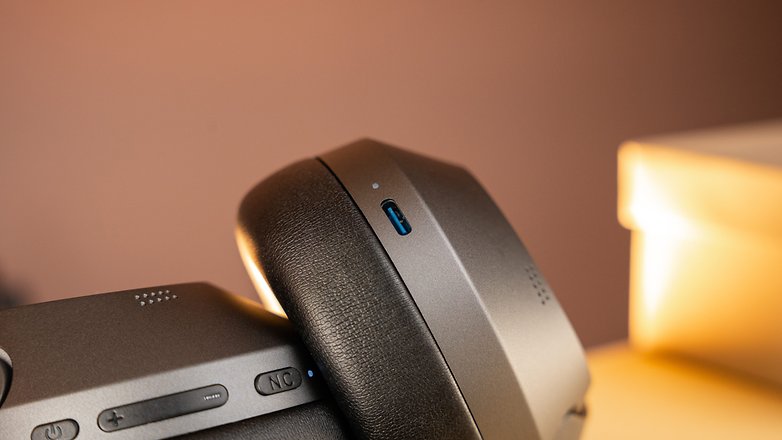
Due to the extremely long runtimes, we have not really been able to find out how the use with and without ANC affects the runtime of the Wave Pro. According to the manufacturer, the runtime drops to 55 hours when ANC is activated, which is still ample. To test the relationship between ANC on and ANC off, we would have to run the headphones for several weeks in test scenarios. However, with regular use with and without ANC while working, the battery level in the EarFun app still shows 90 percent after two days.
Fortunately, EarFun sent us the headphones almost empty—so we were able to test the integrated quick-charging function. With a 30 W power supply, we were able to use the headphones for around three hours after a five-minute charge. Ten hours in ten minutes is therefore quite realistic with a more powerful power supply unit. You should allow two hours to fully charge the 800 mAh battery.
Data sheet
| The product |
EarFun Wave Pro |
|---|---|
| Illustration |
 |
| design |
|
| Audio | |
| Frequency range | |
| ANC |
|
| Bluetooth |
|
| Battery life |
|
| MSRP | $79.99 |
Conclusion
If you use the EarFun Wave Pro in everyday life, you sometimes forget that they cost just $80 according to the MSRP. The sound quality with activated LDAC is on par with significantly more expensive models, the wearing comfort is pleasant even over several hours, and with a battery life of up to 80 hours, EarFun puts all other competitors in its pocket.
However, if you use the Wave Pro without LDAC or wired, the sound quality drops a little too much. At the same time, I repeatedly had to struggle with connection problems during the test, which detracted from the user experience. Here, and with a few other minor problems, it is noticeable that the Wave Pro are inexpensive headphones.
However, this is by no means a bad thing, and overall, EarFun’s first over-ear headphones are truly amazing headphones. You won’t find better sound quality (with Android devices), better ANC, and a longer battery life for $80 anywhere else. This means that the Wave Pro can definitely be seen as strong competition to the equally good Soundcore Space Q45.







